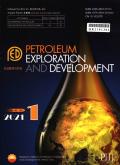Fracture-controlled fracturing mechanism and penetration discrimination criteria for thin sand-mud interbedded reservoirs in Sulige gas field, Ordos Basin, China
IF 8
Q1 ENERGY & FUELS
引用次数: 0
Abstract
Considering the problems in the discrimination of fracture penetration and the evaluation of fracturing performance in the stimulation of thin sand-mud interbedded reservoirs in the eighth member of Shihezi Formation of Permian (He-8 Member) in the Sulige gas field, a geomechanical model of thin sand-mud interbedded reservoirs considering interlayer heterogeneity was established. The experiment of hydraulic fracture penetration was performed to reveal the mechanism of initiation–extension–interaction–penetration of hydraulic fractures in the thin sand-mud interbedded reservoirs. The unconventional fracture model was used to clarify the vertical initiation and extension characteristics of fractures in thin interbedded reservoirs through numerical simulation. The fracture penetration discrimination criterion and the fracturing performance evaluation method were developed. The results show that the interlayer stress difference is the main geological factor that directly affects the fracture morphology during hydraulic fracturing. When the interlayer stress difference coefficient is less than 0.4 in the Sulige gas field, the fractures can penetrate the barrier and extend in the target sandstone layer. When the interlayer stress difference coefficient is not less than 0.4 and less than 0.45, the factures can penetrate the barrier but cannot extend in the target sandstone layers. When the interlayer stress difference coefficient is greater than 0.45, the fractures only extend in the perforated reservoir, but not penetrate the layers. Increasing the viscosity and pump rates of the fracturing fluid can compensate for the energy loss and break through the barrier limit. The injection of high viscosity (50–100 mPa·s) fracturing fluid at high pump rates (12–18 m3/min) is conducive to fracture penetration in the thin sand-mud interbedded reservoirs in the Sulige gas field.
中国鄂尔多斯盆地苏里格气田薄砂泥质互层储层的裂缝控制压裂机理及渗透判别标准
针对苏里格气田二叠系石河子地层第八系(河八系)薄砂泥质层状储层压裂过程中裂缝穿透判别和压裂性能评价问题,建立了考虑层间异质性的薄砂泥质层状储层地质力学模型。进行了水力裂缝渗透实验,揭示了薄砂泥互层储层中水力裂缝的起始-延伸-相互作用-渗透机理。通过数值模拟,利用非常规裂缝模型阐明了薄砂泥互层储层裂缝的垂直起始和延伸特征。建立了裂缝渗透判别标准和压裂性能评价方法。结果表明,层间应力差是直接影响水力压裂过程中裂缝形态的主要地质因素。当苏利格气田的层间应力差系数小于 0.4 时,裂缝可以穿透屏障并在目标砂岩层中延伸。当层间应力差系数不小于 0.4 且小于 0.45 时,裂缝可以穿透屏障,但不能在目标砂岩层中延伸。当层间应力差系数大于 0.45 时,裂缝只能在射孔储层中延伸,而不能穿透地层。提高压裂液的粘度和泵速可以弥补能量损失,突破障碍极限。在高泵速(12-18 m3/min)下注入高粘度(50-100 mPa-s)压裂液有利于苏里格气田薄砂泥互层储层的裂缝穿透。
本文章由计算机程序翻译,如有差异,请以英文原文为准。
求助全文
约1分钟内获得全文
求助全文

 求助内容:
求助内容: 应助结果提醒方式:
应助结果提醒方式:


